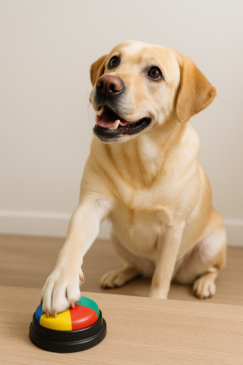When I first heard about “talking buttons” for dogs—those programmable buttons that say words when pressed—I thought it sounded like a gimmick. Sure, dogs can learn commands, but could they really use buttons to talk? Curiosity got the better of me, and I decided to try it with my Labrador, Daisy. I expected a few accidental presses. What I got instead was a whole new way to communicate with my dog.
The First Word
I started with just one button programmed to say “treat.” Every time I gave Daisy a treat, I pressed the button first so she could associate the word with the reward.
For the first few days, she just sniffed the button and looked at me like, Why are you pressing that thing? But on the fifth day, she stepped on it accidentally, heard the word “treat,” and immediately looked up expectantly.
Of course, I gave her one. That was the moment she made the connection.
Adding More Words
Once Daisy understood “treat,” I introduced a second button: “outside.” I pressed it every time we went into the backyard, and within a week, she was pressing it herself when she wanted to go out.
It wasn’t long before she had four buttons:
- Treat
- Outside
- Play
- Love you
The real magic happened when she started combining them.

The First Sentence
One Saturday morning, I was making coffee when I heard two distinct presses: “outside” and “play.” I turned around to see Daisy sitting by the buttons, tail wagging, clearly asking for a game in the yard.
Another time, she pressed “treat” followed by “love you.” I laughed so hard I gave her a biscuit on the spot—partly because it was adorable, and partly because I couldn’t believe how intentional she was being.
The Emotional Surprise
The most unexpected moment came when I sneezed one afternoon. Daisy immediately walked over and pressed “love you.” It wasn’t a request for anything—just a response. That was when I realized she wasn’t just mimicking actions for rewards—she was engaging with me in her own way.
Training Tips
If you want to give your dog a “voice,” here’s how I made it work:
- Start Small – Begin with one or two essential words, like “treat” or “outside.”
- Model Consistently – Always press the button before performing the action so your dog connects the sound with the event.
- Reward Correct Presses – Give treats or praise immediately when they use the button appropriately.
- Add Gradually – Only introduce new buttons after they’ve mastered the first ones.
- Keep Sessions Short – Five to ten minutes at a time is ideal to avoid overwhelming them.
The Reactions
When I shared a video of Daisy pressing “play” and then “love you” online, it blew up. People were fascinated, and comments flooded in:
- “This is the sweetest thing I’ve ever seen.”
- “Dogs are smarter than we give them credit for!”
- “I’m ordering buttons right now.”
Some people were skeptical, saying it was just conditioned behavior. But whether or not she truly “understands” in human terms, the fact is she uses the buttons intentionally to communicate—and that’s more than I ever imagined.
How It Changed Our Bond
Before the buttons, I thought I knew Daisy well. I could read her body language and interpret her barks. But the buttons gave her a way to initiate conversations. Now, instead of guessing what she wants, I can hear it—literally.
It’s deepened our connection in ways I didn’t expect. I feel like I’m listening to her instead of just observing her.
Moving Forward
Daisy now has ten buttons, including “water,” “ball,” and “walk.” Every time she learns a new one, it feels like another door opening between us.
And while it started as a fun experiment, it’s become one of the most meaningful parts of my relationship with her. I can’t imagine going back to the days when her only way to “talk” to me was with a bark or a stare.
Final Thought
Giving your dog a “voice” isn’t just about teaching them a trick—it’s about unlocking a new level of understanding. Once you hear them “speak” in their own way, you’ll never look at them the same again.

